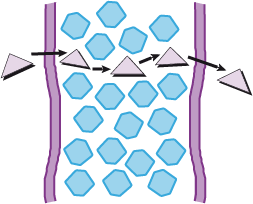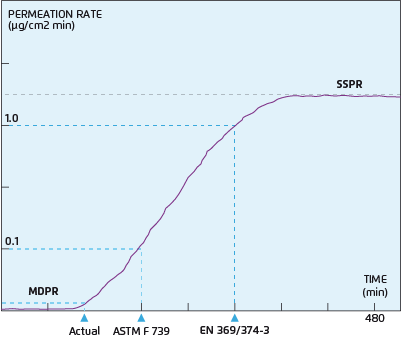Resistance to Permeation by Chemicals EN6529:2001
WHAT IS PERMEATION?

Permeation is the process by which a hazardous liquid chemical moves through a protective clothing fabric, at a molecular level. Permeation can be represented by the following simplified diagram.
- Sorption of molecules of liquid onto the contacted (outside) surface of the fabric.
- Diffusion of the sorbed molecules across the fabric.
- Desorption of the molecules from the opposite (inside) surface of the fabric.
MEASURING PERMEATION
The barrier properties of a protective fabric or protective seam to permeation by a potentially hazardous chemical, is determined by measuring the breakthrough time and the permeation rate of the chemical through the test material. Permeation tests are conducted following the ASTM F739, EN 369 or EN 374-3 test methods depending on the country of use and their local regulations and the physical state of the hazardous material.
The outside surface of a test fabric is exposed to a liquid chemical or gas using a permeation test cell. Breakthrough of the chemical to the inside fabric surface is monitored by sampling the collection side of the cell and analytically determining when the chemical has permeated across the fabric by use Mass Spectrometer techniques.
Permeation rate (PR)
The rate at which the hazardous chemical permeates through the test fabric. Permeation rate is expressed as a mass of hazardous chemical flowing through a fabric area per unit of time e.g 2.0 µg/cm2 / min. or 2 millionths of a g per square centimetre per minute
Steady state permeation rate (SSPR)
The constant permeation rate that occurs after breakthrough when the chemical contact is continuous and all forces affecting permeation have reached equilibrium
Minimum detectable permeation rate (MDPR)
The minimum permeation rate that can be detected during a permeation test .MDPR is a function of the sensitivity of the analytical measurement technique, the volume into which the permeated chemical is collected and the sampling time. Minimum detectable permeation rates can be as low as 0.001 μg/cm2 per minute in certain cases.
ACTUAL BREAKTHROUGH TIME OR BREAKTHROUGH DETECTION TIME (BDT)
The average time elapsed between initial contact of the chemical with the outside surface of the fabric and the detection of the chemical at the inside surface by the analytical device.
An actual breakthrough time of >480 minutes and a permeation rate of “nd” (not detected) does not mean breakthrough has not occurred. It means that permeation was not detected after an observation time of eight hours.
Permeation may have occurred, but at a rate less than the minimum detectable permeation rate (MDPR) of the analytical device. MDPR can vary depending on the chemical or on the analytical device.
When selecting a chemical barrier fabric, the MDPR and expected exposure times are used to determine if the level of protection is sufficient taking into account the toxicity of the chemical used.
NORMALIZED BREAKTHROUGH TIME –ACCORDING TO ASTM F739
The average elapsed time between initial contact of the chemical with the outside surface of the fabric and the time at which the chemical is detected at the inside surface of the fabric at a permeation rate of 0.1 μg/cm2 / min.
NORMALIZED BREAKTHROUGH TIME – ACCORDING TO EN 374-3
The average elapsed time between initial contact of the chemical with the outside surface of the fabric and the time at which the chemical is detected at the inside surface of the fabric at a permeation rate of 1.0 μg/cm2 / min. Thus the breakthrough time is ‘normalized’ as it is independent of the analyser sensitivity. Here the lowest BT is recorded.
A normalized breakthrough time of >480 minutes means that the average permeation rate never reached the defined rate of 1.0 μg/cm2 /min. However the chemical may have actually broken through but at a lower rate.

PERFORMANCE CLASSIFICATION OF NORMALIZED BREAKTHROUGH TIMES
According to the European standards for Chemical Protective Clothing, the resistance of clothing materials to permeation by chemicals must be measured according to EN 369 or EN 374-3. The normalized breakthrough times are classified into six performance classes. For the European standard, the correlation table between the normalized breakthrough time in minutes and the performance class is shown in the followingtable
| Breakthrough time (EN 369) in minutes | EN Class |
|---|---|
| >= 10 | Class 1 |
| >= 30 | Class 2 |
| >= 60 | Class 3 |
| >= 120 | Class 4 |
| >= 240 | Class 5 |
| >= 480 | Class 6 |

